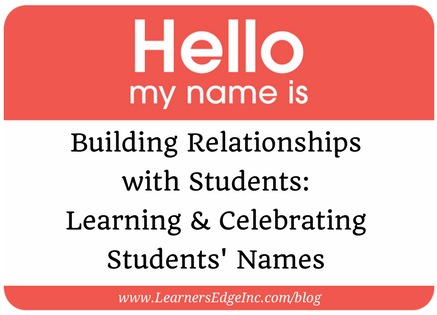
There are many strategies teachers can use to help in building relationships with students at the beginning of the school year. First and foremost, however, is one that we tend to take for granted: knowing students’ names. It’s not only important for teachers to learn student names, it’s important for kids to learn each other’s names as well. We want students to know each other and to feel comfortable working together. Community matters, and learning names is the first block in community building!
The authors of Better Than Carrots or Sticks: Restorative Practices for Positive Classroom Management1 stress the importance of learning student names quickly, “especially for vulnerable students who may feel disconnected from the learning community and for students who have names that are easily mispronounced.” It’s true that getting to know students means learning how to say their names correctly and this can be challenging, especially at the beginning of the year. Teacher and author Ambereen Khan-Baker3 believes the effort is important: “Pronouncing students’ names correctly conveys important messages: I care about you, I accept you, and you are important to me. By modeling this behavior, teachers can cultivate a classroom climate that is equitable and fair to students.” The My Name, My Identity campaign, created by the Santa Clara County Office of Education, is now a nationwide movement to encourage the correct pronunciation and celebration of student names.
If you are new to teaching or struggle to learn students’ names quickly because you have large class sizes, it’s a great idea to develop a plan before the school year even begins. The best advice I received as a new teacher was to avoid reading names aloud from a list in front of the class before connecting with students. It is so easy to mispronounce names and embarrass students in front of their peers. Instead, I stood at the door and greeted students individually, asking each student their name, or I incorporated classroom “meet and greet” activities that allowed students to introduce themselves to the class first. When I subbed for other teachers, I liked to get students started on an activity and then walk around the classroom to check in with students personally while taking attendance. These personal moments not only help you learn student names correctly, they also build classroom trust and respect. Remember it’s okay to let students know it may take you time to learn their names. I often told my students on the first day of school, “It may take me time to learn your name, but I will keep trying. Your name is important to me.”
I not only made it a priority to learn students’ names, but to celebrate them in my classroom. At the start of the year, I tried the celebration of names to my curriculum lessons. In American Literature, students made posters with their name, photos or drawings of themselves and their families, and mottos and images they felt represented their identity. While they worked creatively at their desks and in small groups, I walked around the room chatting with each student and confirming both their name pronunciations and any nicknames they preferred. We then constructed an American Quilt on the wall with these posters and referred to it throughout the year for inspiration. These classroom activities early in the year help students connect with one another, too!
Looking for a few more ideas to learn student names? Check out these ideas from Eric Jensen’s book Poor Students, Rich Teaching: Mindsets for Change!2
Introductions: At the start of the school year, have students say their names every time they speak. Do this for the first thirty days of class.
Likes: Do a quick energizer each day asking students to stand in areas of the room by likes or dislikes: “If you like green vegetables, stand here. Stand here if you are a St. Louis Cardinals fan.” The point is to help you remember students’ names by associating them with their preferences.
Returns: When you return papers, use names as you give the paperback to the student: “I loved your reference to chocolate cake in this story, Robert!” Remember to make eye contact with each student as you speak to them.
Interviews: Give students 3-5 minutes to pair up and interview each other and discover at least three unique things about them “no one will forget.” (It’s helpful to provide a list of fun questions students can use during the interview). Each pair stands and introduces each other. Make it the partner’s role to teach the class proper name pronunciation to take the pressure off of shy students who may be hesitant to correct their peers.
‘Formal Greetings’: Until all students know each other’s names, have students introduce themselves to new partners each day with eye contact, a greeting, and a handshake. Model this process, if needed, and have fun with it! If this seems silly, it’s not! Strong social glue builds respect and trust.
These relationship building activities are a great way to help start your school year off right and create a classroom community. Which of the activities listed above have you used before, or do you plan to use this year? Comment below, or feel free to add in your own favorite way to build relationships with your students.
Sources:
- Fisher, D., Frey, N., and Smith, D. (2015). Better Than Carrots or Sticks: Restorative practices for positive classroom management. Baltimore, MD: ASCD.
- Jensen, E. (2016). Poor Students, Rich Teaching: Mindsets for change. Bloomington, IN: Solution Tree.
- Khan-Baker, Ambereen. (2016, August 12). Why pronouncing students names is important to building relationships. Retrieved from http://www.nbpts.org/why-pronouncing-students-names-is-important-to-building-relationships/
***








